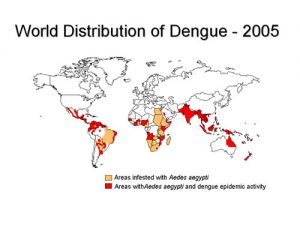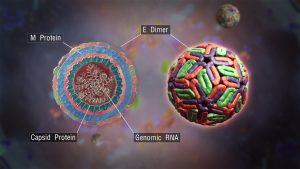One day, while you are on a tour through India, you notice that mosquitoes have bitten you several times while you were unaware. You disregard it, thinking that these bites have never amounted to anything more than an annoying itch on a bump in the past. However, several months after returning home, you begin to feel fatigued, nauseous, as well as sporting a severe headache. At this point, you may have been infected with Dengue fever virus.

General cross-section view of a Dengue virus particle. From Wikimedia Commons.
According to an article published by Anne Gubler in Trends in Microbiology, Dengue fever virus originated from the tropical regions of the Earth during the 18th to 19th centuries. The virus is mainly spread through a species of mosquito referred to as Aedes aegypti, which still populate the tropical and some subtropical regions today. However, as human population continues to rise in these areas, the risk for another epidemic outbreak further increases. This is due to the ease at which a mosquito can travel from host to host, spreading the virus at a much higher speed.

General cross-section view of a Dengue virus particle. From Wikimedia Commons.
The structure of a Dengue viral particle consists of a core, an envelope, and proteins attached to it. The core contains the genetic information of the Dengue virus. This genetic information codes for the eventual production of a new viral genetic strand, as well as the creation of a new core, envelope, and envelope proteins. The viral envelope can fuse with a host cell membrane, and also allows for the attachment of proteins. The envelope proteins are used to attach the virus to the receptors located on the outside membrane of a host cell.
A study done by Karen Clyde sheds light on how the virus uses a replication cycle that involves entering a healthy host cell and hijacking numerous cell mechanisms to complete replication. Firstly, the virus binds to a host cell using its envelope proteins. Secondly, the host cell internalizes the virus, resulting in the release of the viral package inside the cell. The next step involves the generation of a viral replication enzyme using host cell structures before the virus genome can be replicated. This eventually results in the production of a chain of viral proteins, which are cleaved apart to form the final product of a core surrounded by an envelope with proteins.
Next time you travel through a country at risk of Dengue infection, make sure to coat yourself in bug repellant. As there are no known vaccines or treatments for Dengue, once infected, it will accompany you for the rest of your life. Therefore it is up to you to take appropriate precautionary measures to protect yourself.
-Angus Lee

One response to “Dengue Fever Virus: What Is it?”